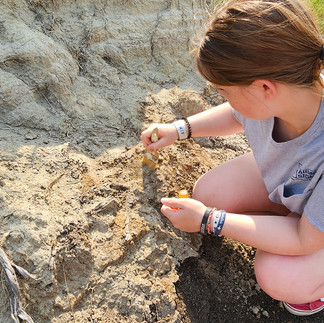Dinosaurs and Dark Skies Highlight Visit to Southeast Montana
- Vanessa Orr
- Dec 30, 2023
- 4 min read

For those of us who grew up watching Jurassic Park movies, the idea of unearthing something as momentous as a dinosaur bone is intriguing. But when it comes to actually taking part in an archeological dig in Montana, the real-life experience is actually a little more surprising.
“There’s a dinosaur bone,” says one of our guides, pointing out a bone shard sitting on the ground in the Hell Creek Formation in Ekalaka, MT. “And there’s another one—right there on the surface.”

It turns out that finding dinosaur bones in Montana isn’t quite as difficult as you’d think, which is why it’s the perfect place to channel your inner Indiana Jones. In fact, 65 million years ago dinosaurs roamed over most of the state, and their story, as well as many of their bones, can be discovered along The Montana Dinosaur Trail.
Not only was the first Tyrannosaurus rex fossil—and the largest Tyrannosaurus rex ever unearthed—found in Montana, but after Maiasaura nests were found near Choteau, MT, this ‘mother lizard’ was named as Montana’s official state fossil. So you know these people take their dinos seriously!
Established in 2006, the Dino Trail provides opportunities for visitors to learn more about these creatures as well as the times in which they lived. Montana’s landscape, much of which was formed by folding and shifting rock, features exposed rock formations from nearly every geologic era, including the Cretaceous and Jurassic periods. Because the state is sparsely populated, many of these sites remain undisturbed by development.
However, identifying these bones—and properly unearthing them from their places of rest—isn’t easy, especially for novice dinosaur bone hunters. Montana is made up of private, state and federal lands, and you usually need either permission or a permit, depending on where you want to dig. The good news is that any Montana Dinosaur Trail facility can let you know about guided dig opportunities so you can help contribute to paleontological study in the right way.
FOLLOWING IN THEIR FOOTSTEPS
The 2,000-mile Montana Dinosaur Trail crosses the central and eastern parts of the state and includes 14 separate sites and museums, all of which offer something different. The Montana Dinosaur Center in Bynum, MT, for example, offers hands-on dinosaur dig expeditions throughout the summer; the Museum of the Rockies in Bozeman, MT has an extensive collection of dinosaur fossils as well as the “Big Al” Allosaurus. The Fort Peck Interpretive Center and Museum, in northeast Montana, features “Peck’s Rex,” one of the most complete Tyrannosaurus rex skeletons ever found.
The Carter County Museum in Ekalaka, located in southeast Montana, is Montana’s first county museum and the first to display dinosaurs found in the state. Exhibits include a complete skull of Triceratops, as well as mounts and casts of pachycephalosaurs, mosasaurs, plesiosaurs, ankylosaurs and the first and most complete juvenile T. rex, all of which were found in Carter County. For those wanting a look at human life as well, the museum also features exhibits on ancient and modern American Indian history and local legacies, such as the man behind the Tooke Bucking Horse, homesteader stories and tales of local veterans.
The museum also encourages future paleontologists through its Camp Clades and Spades summer camp, offered in partnership with the Montana Learning Center, which enables 9th-12th graders to experience three days of field expeditions to active paleontological dig sites. Insanely popular, the camp sold out in six minutes when it opened for enrollment last year.
In addition to the many museums on the trail, visitors can also enjoy a stop at the stunning Makoshika State Park in Glendive, which is part of the Late Cretaceous Hell Creek Formation. More than 10 different dinosaur species have been discovered in the park, including a complete Triceratops horridus skull, which is on display in the visitor center. The park also has wonderful hiking trails, and camping is available for those who want to make more than a day of it.
Those who choose to spend a night in southeast Montana will also appreciate the fact that Medicine Rocks State Park, less than a 20-minute drive from Ekalaka, is a certified International Dark Sky Sanctuary, which means that it is perfect for star-gazing. A place of ‘big medicine’ where Indigenous American hunting parties gathered, the park is filled with large sandstone rock formations, giving it an otherworldly appearance.
CREATURE COMFORTS
While it’s exciting to lie on the sandy ground gently brushing dirt away from a newly discovered bone, it’s not exactly comfortable, which is why towns near The Montana Dinosaur Trail offer a variety of relaxing lodging options. Restaurant choices also abound, and include everything from old-fashioned diners to ‘elegant comfort food’ to old-time bar & grills that feature casual food and impressive Montana history.
To learn more about The Montana Dinosaur Trail as well as what else to see in different areas of the state, visit https://mtdinotrail.org. Other information can be found at www.visitmt.com and https://southeastmontana.com.
THE MONTANA DINOSAUR TRAIL
Planning a visit? Check out the following stops.*
Blaine County Museum: blainecountymuseum.com
Carter County Museum: cartercountymuseum.org
Depot Museum: rudyardmuseum.wordpress.com
Fort Peck Interpretive Center and Museum: fws.gov/refuge/Charles-m-russell/fort-peck-interpretive-center
Frontier Gateway Museum: frontiergatewaymuseum.org
Garfield County Museum: 406-557-2544
Great Plains Dinosaur Museum and Field Station: greatplainsdinosaurs.org
H. Earl Clack Memorial Museum: hearlclackmuseum.com
Makoshika State Park: stateparks.mt.gov/Makoshika
Museum of the Rockies: museumoftherockies.org
Old Trail Museum: oldtrailmuseum.org
Phillips County Museum: phillipscountymuseum.org
Montana Dinosaur Center: tmdinosaur.org
Upper Musselshell Museum: harlowtonmuseaum.org
*Contact for hours of operation. Not all museums are open year-round.




































Comments